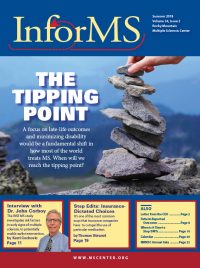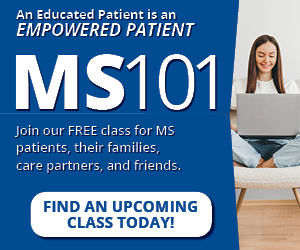One of the most difficult decisions for someone who’s been living with MS for a long time is whether or not to discontinue their treatment with disease modifying therapies (DMTs). Is there a point when MS “slows down” and DMTs just aren’t as helpful as they had been earlier in a patient’s life? To date, there’s been no research into this possibility, but the Rocky Mountain MS Center at University of Colorado (RMMSC at CU) is spearheading an eff ort to get some answers.
RMMSC at CU was awarded a research grant from the Patient Centered Outcomes Research Institute (PCORI) to study discontinuation of DMTs in older MS patients who have remained stable for a period of time. We recently sat down with Dr. John Corboy, Co-Director of RMMSC at CU to learn more about the study.
RMMSC: Could you please explain what makes a grant from PCORI unique?
Dr. Corboy: PCORI is a private, nonprofit entity and it was developed as an offshoot of the Affordable Care Act with the goal to do patient centered research focusing on comparative effectiveness. Unlike a National Institute of Health (NIH) grant, or other sources of funding, it’s specifically required that you engage patients and related stakeholders − from the design, through the completion and dissemination of information about the research.
The truly unique aspect is the engagement of patients and stakeholders. Patients can give researchers very helpful insights in how we approach various studies and can challenge our way of thinking. For our study, we have Stakeholder Advisory Committees (SACs) which will be composed of not only patients and caregivers, but also pharmaceutical companies, medical insurers, one of our state legislators, and our research team to engage multiple stakeholders at multiple different levels.
RMMSC: What question is this study seeking to answer?
Dr. Corboy: The main question that this study is seeking to answer is: Can we define a population of patients in whom it’s safe to discontinue their disease modifying therapy (DMT) for MS as they age? The natural history of MS is that, as people age, the risk of having new relapses and the risk of having new inflammatory markers on their MRI scan is less frequent. And, if you look at people across an age range, we fi nd that people who die when they are younger have many inflammatory lesions; whereas people who die when they are older with MS have very few, if any, inflamed lesions.
The reality is that MS is both an inflammatory and a neurodegenerative disorder. The inflammatory component is most prominent when people are younger. The importance of that is that the DMTs that are presently available are all anti-inflammatories of one form or another. However, there has not been much benefit detected in the neurodegenerative realm, especially in Progressive MS which, essentially, reflects aging MS.
That means that there’s a change in the natural history of MS and that the medicines that are geared toward the inflammatory component have their biggest effects when people are young. That has been shown in the relapsing AND progressive studies when you look at sub-group analysis of existing DMTs. For example, in the Gilenya studies, if you look at people who are younger than 40 vs. over 40, the largest benefits by far are in those under the age of 40. And multiple studies, even Tysabri studies, which is arguably our best medicine, show the same thing. If you do a cut below 40, the differences are profound.
It’s fairly clear that these medicines will have greatest benefit to people when they are younger. Then the question becomes: Are we able to identify that, as people age, the risk of new inflammatory disease activity becomes so low that any benefit you achieve does not outweigh the cost, risk, side effects, and the hassle factor that go along with taking a medication on a regular basis? We do not know the answer to that question.
RMMSC: Have other studies tried to address this question?
Dr. Corboy: The agenda for these types of studies have been driven by pharmaceutical companies. The disease modifying therapies that we have for MS would not exist without studies conducted by pharmaceutical companies, which is hugely beneficial. So I’m not complaining that they do the studies. They have their purpose; it’s just not necessarily what the patients’ or what ours would be.
The reality is that there are zero prospective trials in this context, that is, possibly discontinuing therapies over time. There are in some studies for other conditions, including randomized discontinuation trials in arthritis, in cancer and perhaps other conditions as well.
So what do we have in our world? We have our own anecdotes: doctors that have taken people off medications and we’ve just followed them — mostly just randomly, but some with a specific purpose in mind, and they’ve tried to report them. There have also been retrospective studies which have provided valuable information but are limited in their conclusions.
RMMSC: What makes this study’s approach different?
Dr. Corboy: As an alternative to that retrospective approach, our study is a randomized, controlled, prospective discontinuation trial. As presently planned, this will consist of 300 patients at 12 sites in the United States, so in theory each site will have 25 patients. It will be randomized − some people will be asked to discontinue their medications and some people will be asked to stay on their medications.
It will include all the standardized medications that are FDA approved, with the exception of alemtuzumab (Lemtrada) because it’s a long-lasting medication and not that many people have used it, so we didn’t think we’d lose much value. You cannot have been on any experimental agents and you can’t be on any off-label drug, such as rituximab (Rituxan).
This is a non-inferiority study. You can do studies where you try to prove something is better. You can do studies that show something is inferior. You can try and show something is equivalent. Or you can show something is not inferior: the hypothesis is that when you take people off of DMTs they will do no worse than the group that stays on their DMTs.
It’s also a prospective study. That means that people enter the trial, they’ll be randomized, and the data will all be collected ahead of time. The primary outcome measure is the question: Is there a diff erence between the two groups in people that have a relapse or a new lesion on their brain MRI scan over the two year period of time?
The secondary outcome measure would be change on your Expanded Disability Status Scale (EDSS) – we will assess the percentage of people who worsen at least one point on the EDSS, a measure of disability. The other secondary outcomes measures are patient reported outcomes. And each patient at each visit will be asked to participate in patient reported outcomes questionnaires as to their quality of life, fatigue, mood, and a host of functions.






